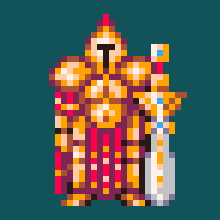Hello! I've recently discovered fantasy consoles and this seems to be the biggest one in terms of community. What I'm curious on is why someone new to fantasy consoles should use this one over others? Sorry if this question has been asked numerous times but I'd like to know the reasons to use this over others before I drop $15 lol

Pico-8 probably has the biggest community around it.
And the fake-console's limitations are set in stone. You can't change a config file to get higher resolution, for example. Everybody works to the same specs. (Which depending on what you're hoping to get out of it could be good or bad.)

The biggest factors for me have been:
1. Availability of documentation
It's not perfect, but between the PICO-8 manual, the PICO-8 wiki, and the Lua manual (current Lua manual here, Lua 5.2 manual here) I've been able to answer most questions I had without having to ask for help (which would have been a major roadblock).
Plus, resources like the Game Development with PICO-8 zine and Gruber's PICO-8 music tutorials do a lot to help someone new get started.
2. Ease of sharing games
You can post a .p8 file. You can post a .png file. You can export to HTML. You can export binaries for Windows, Mac, or Linux.
And you can run PICO-8 on an old cheap laptop. When I see the Unity logo pop up in a web player, I am filled with dread; when I see the PICO-8 logo, I have no fear. The memory and CPU limitations determine that.
(And, by the way, not every fantasy console imposes CPU limitations. As it works out, I rarely have problems with TIC-80 carts, but people definitely have before.)
3. Coherency of design
zep's PRACTICE 2018 talk is kind of all about this, but PICO-8's limitations are pretty carefully and intentionally crafted around making the experience of working with PICO-8 both easy and inspiring. One thing I repeatedly say is that you can do anything in PICO-8, just not very much of it, and that's on purpose - because you can't do very much, it's totally okay to just ... not do very much. I wrote a slightly-buggy version of the old videogame "Chase" (I knew it as Daleks, because my parents had a Mac Plus) in a day, with custom graphics and sound effects, and felt good about that - it's not pushing any limits but it doesn't have to.
Also, I wrote a slightly-buggy version of "Chase" in a day, with custom graphics and sound effects. Lua is pretty easy to program in, the PICO-8 sprite editor is pretty easy to work with, the PICO-8 sound effects editor is pretty easy to work with, and all the pieces connect together and work very quickly without a lot of glue code.
...but also you can do pretty epic things with it. I was playing games like Sophie Holden's "Dusk Child" and NuSan's "Combo Pool" and Krystian Majewski's "Mai-Chan's Sweet Buns" before I knew what PICO-8 was, and they were great - it's totally possible to make something genuinely impressive with it. As limiting as the limitations are, they leave the developer enough space to do some remarkable things.
And the limitations are inspiring, too. "How do I draw recognizable wisteria blossoms in a 16 by 24 pixel rectangle with only these 16 colors?" is both an interesting challenge and a challenge I could absolutely meet with some photo reference and some thought - they're good colors that work well together. "How do I make something that feels like a bass guitar riff with these eight waveforms and seven effects?" is another interesting challenge and one I could meet. (Or at least assume I have - I don't play the guitar.) "How do I animate dialogue boxes and advance background music programmatically as the player proceeds through the text of the essay I wrote?" - again, interesting challenge, and again, one I could meet.
(Could I have used a library for dialogue boxes? No, PICO-8 doesn't have proper libraries. You find code someone else has written to adapt or you figure it out yourself. Which, again, is on purpose - zep doesn't like writing glue code, and he wanted writing PICO-8 code to be about interesting problems and not trying to wire pieces you don't understand together.)
On which note:
4. I understand what my code is doing.
One of my first jam games was in LÖVE/Love2d and used a library for collision handling.
Collision handling: worked fine.
The system I wanted to build that used collision data to function: was severely broken.
My ability to debug it: completely inadequate, because I didn't understand what it was doing.
In PICO-8, I can understand what my code is doing. I know how my code draws triangles. I know how my code draws shadows. I know how my code calculates friction. I know what it's doing, where it's doing it, and why it's doing it. This is a very personal thing - honestly, everything on this list is a bit personal, but this one is more so - but I hate having a program that I don't understand acting in ways I don't understand.
My PICO-8 programs I understand.
-~-~-~-~-~-~-~-~
I'm not gonna say that other fantasy consoles don't do these things, or don't do better things - I haven't done anything like a thorough study of them - but these are things that make PICO-8 stand out for me.

@packbat Love this explanation!
@kiiwii I am a complete beginner at making games, but PICO-8 and the community around it have both made it fun and achievable for me to make a game I've wanted to make for quite awhile. There is code to study everywhere - snippets in these forums, tutorials galore, the source code to pretty much every cart on here, a whole ecosystem of tweetcarts that I find help make some of the math more accessible. The thing I find most compelling though is while I'd usually just want to cut & paste stuff that other people have already done because there's still sooooooo much code to write, with PICO-8 I more often want to learn from it and then try writing things myself. The limitations really make me think about what's important for my game instead of trying to cram it all in. It's a learning tool that also provides a lot of immediate gratification. Very addictive once you get started!

"Coherency of design"
This is probably a big one. Zep has really worked hard to make a fantasy console.
Not a toolkit for making retro-games, but a fantasy console, and he's kept that in mind the whole time.

@apLundell: Actually, if I'm understanding the PRACTICE-2018 talk correctly, it's even less about making retro-games than the description "a fantasy console" would imply - the idea of a fantasy console only came later in the process. I think the focus that makes PICO-8's design so coherent was on the simplicity of 1980s hardware to develop on - when I was trying to write a version of Chase/Daleks on a TRS-80 Model 100 as a wee child, I didn't have to figure out which graphics libraries to include and which compiler flags to set, I just wrote some BASIC code that didn't work.
And when I tried again last month in PICO-8, I didn't have to figure out which graphics libraries to include and which compiler flags to set, I just wrote some Lua code that didn't work. I didn't even have to open Notepad++, although I usually do for PICO-8 programming because the larger screen size helps; I could do everything in PICO-8's built-in editor.
Like, I think the concept of a fantasy console was really useful to us, to tell us that this is something with its own identity but the carts we make for it are our own and not 'just' mods, but I think it's deceptive to someone trying to make a tool that works as well as PICO-8. PICO-8 is not about being like the Atari 400 or the Amiga 500 or the Commodore 64 or the Nintendo Entertainment System - it's about the feeling of freedom that comes from working with a smaller machine, one where you don't have to build an entire infrastructure before you can make anything happen, one which includes the tools you need instead of forcing you to find or build them, one which makes you proud to have pulled off the most basic things even as it makes it easier for you to do those things. One which you want to hear the startup chime for, not one which makes you stress out to start working with.
Frankly, I think PICO-8 is less like any actual machine that existed and more like Bitsy Game Maker or Twine. You can just make stuff. All the stuff you need to make stuff is right there. And by trying to make stuff with these tools, it gives the stuff a sense of identity without your even trying - when start playing a Bitsy game or a Twine game or a PICO-8 game, I know immediately what it is, even as I don't know what it's going to turn out to be.
...sorry, I'm just ... very enthusiastic about this tool. It's been incredible for me as a creative outlet, and I've spent a lot of time thinking about it trying to infer why.

One thing I don't understand is why the phrase "fantasy console" has stuck.
Pico-8 is far more like a "Fantasy 8-bit Home Microcomputer" than a console of any description.
It's what all those old 80s home-computers tried to be, but couldn't quite achieve.

I guess maybe exported PICO-8 games feel more standalone and less general-purpose than actual have-bought-the-thing PICO-8 does?
I know TIC-80 brands itself as a "fantasy computer", though, and I've seen lists of stuff like PICO-8 and TIC-80 describe their contents as "fantasy consoles and computers".

Design-wise Pico internals are designed in a very similar way a game console (or home-computer leaning towards games) was designed in the early days... UDGs (User Defined Graphics memory, on 8x8 size but with variable 2^n grouping), dedicated/optimized gfx memory to screen blitting, memory banks (spr bank, map bank, sound banks...), pure chiptune sound (including noise generator)... it resembles a classic arcade board from the 80s or a NES. The main difference is you have a programming language and API on it and not just pure ASM (which reduces the initial learning curve). With that design you can go vanilla (use mostly the api and enjoy) or go low-level and push the specs (and your own...) limits hard. It's perfect for both, hobbyst casual coders and hardcore low-level freaks... even I'd say it is great to evolve through the journey from one to the other.

Not only did Pico-8 really get me into programming,
I also still love making games for it even though I try other stuff still.
I'll be making games in other engines or environments at some point, but I'll always like returning to make a pico-8 game for fun.

Okay, well I think I'll use pico-8 then! I've got one question though and this is a bit specific...
So the payment methods for buying pico-8 is Paypal, Card and via Amazon. What I need to know is if I can pay via Amazon with Amazon gift cards? I don't have a card so I can't pay with that or paypal and I have ~$35 in Amazon gift cards.

Oh, hrm.
It looks like Amazon gift cards don't work - I'm not sure how to do purchasing without a card...

> It looks like Amazon gift cards don't work - I'm not sure how to do purchasing without a card...
It's fine I'll try to find a way! ^^

@apLundell
> One thing I don't understand is why the phrase "fantasy console" has stuck.
I think it's partially because, conceptually, a PICO-8 doesn't actually have a keyboard.
Yes, we program it with a keyboard, but that's because when you're in programming mode, it's more like you're using a devkit. When you run your game, you should imagine yourself picking up a gamepad and swiveling your chair from your keyboard & monitor to face a TV, as one might've done when working on games in the 80's and 90's.

@apLundell @Felice Err...Pico-8 is most similar to a third generation console, which would place it during the time when consoles having keyboards was still normal. Even the Famicom had one.
That said, I've got no explanation for the 16 disk drives.

I think of PICO-8 conceptually as somewhere between a NES and a SNES, but at a lower resolution. And yeah the Famicom could be used with a keyboard, but the western versions were just gaming devices. In the west consoles haven't been marketed with keyboards ever, except maybe the Coleco Adam, but that would pre-date the era PICO-8 is nestled into.
[Please log in to post a comment]










